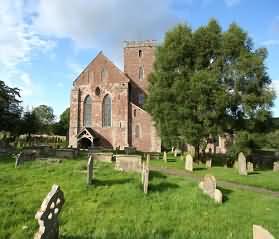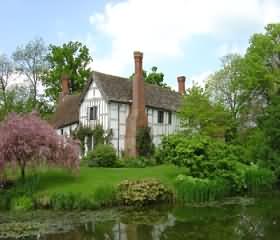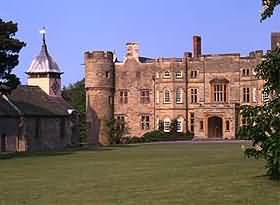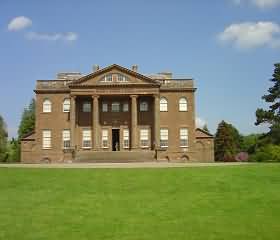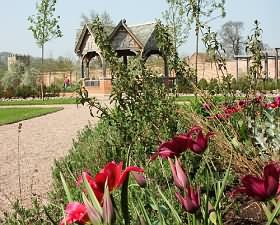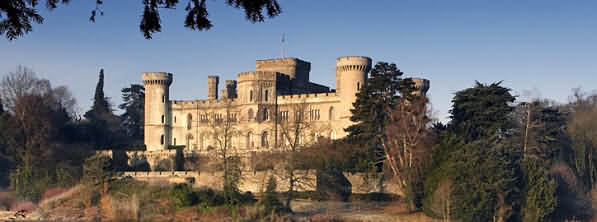 |
|
|
Dore Abbey |
|
Dore Abbey was founded as a Cistercian Abbey by Lord Robert D'Ewyas in 1147. It was consecrated by the founder's brother-in-law, St. Thomas Cantilupe. The abbey flourished in seclusion for almost four hundred years before Henry VIII's Dissolution of the Monasteries swept away the nave and all associated monastic buildings.
The church is an interesting survival of the Dissolution, for essentially it did not survive. It was granted to the Scudamores who used it as a stone quarry for a hundred years. In 1632, however, the 1st Viscount Scudamore influenced by his friend, Archbishop Laud, decided to restore what remained of the chancel and transepts and add the little tower that we see today.
Hence, internally, the church is filled with a fine collection of Carolingian ecclesiastical furniture: the chunky screen proudly displaying the arms of Charles I, Scudamore and Laud. The original twelve foot stone altar slab was restored after being used for making cheese in a local farm.
Other interesting features of note include the musicians' gallery (c.1700), good effigies of D'Ewyas and his half-brother, the heart burial of a Bishop of Hereford, medieval floor tiles and a wide array of fascinating roof bosses (now at ground level). The building is well laid out for visitors with guide books for sale and nicely illustrated information boards to read. |
|
| Location |
Contact |
| In Abbeydore village on B4347 |
Dore Abbey, Abbeydore, Hereford HR2 0AD |
| Opening |
|
| Daily |
w - doreabbey.org.uk |
| |
|
| Admission |
|
| Free |
|
| |
|
| Notes |
|
| Beautiful Grounds and ideal for picnics |
| |
|
| |
|
| |
|
|
|
Brockhampton Estate |
|
This 1700 acre estate was bequeathed to the National Trust in 1946 and still maintains traditional farms and extensive areas of woodland, including ancient oak and beech. Located on the Herefordshire/Worcestershire borders.
At the heart of the Brockhampton estate lies Lower Brockhampton House - a medieval 14th-C moated manor house with a beautiful timber framed gatehouse. Visitors can see the Great Hall, open to the rafters which were constructed from wood from the estate.
Discover the ruined Norman Chapel near to Lower Brockhampton.
There are miles of walks across the Brockhampton estate through park and woodland and includes sculptures with a local theme.
The Brockhampton Estate is home to a rich variety of wildlife including the dormouse, buzzard and raven.
Sample the local specialities in the tearoom and visit the imaginatively stocked shop selling mostly local produce and crafts.
The ground floor of Lower Brockhampton House and tearoom are accessible. Please telephone 01885 488099 for details of facilities for visitors with disabilities. |
|
| Location |
Contact |
| 2 miles east of Bromyard on the A44. |
Brockhampton Estate, Greenfields, Bringsty, WR6 5TB |
| |
|
| |
w - nationaltrust.org.uk |
| |
t - 01885- 488099 |
| Admission |
Opening |
| Adult £3.60, Child £1.80 |
House - Mar Sat & Sun 12 noon to 4pm; Apr to Sep Wed to Sun 12 noon to 5pm; Oct Wed to Sun 12noon to 4pm.
Estate - All year dawn to dusk
|
| |
| |
|
|
Eastnor Castle |
|
| Details |
| Nearest Train Station: |
Ledbury
|
| Nearest UK Airport: |
Birmingham |
| Months Open: |
Sundays and BH Mondays from Easter - 1st weekend in Oct
Every day in July & Aug except Saturdays
11am - 5pm (last admission 4.30pm) |
| Groups/Parties Welcome: |
Yes |
| Discount for Groups: |
Yes |
| Car Parking: |
Yes |
| Admission Price: |
Adults: £7
Senior Citizens: £6
Children: £4
Family Ticket (2 adults, 3 children): £18 |
| Gift Shop: |
Yes |
| Catering: |
Café |
| Website |
www.eastnorcastle.com |
|
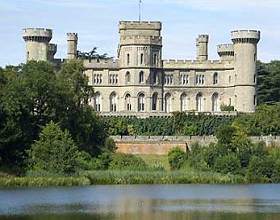 |
| Fairytale Georgian castle dramatically situated in Malvern Hills and surrounded by deer park, lake and famous arboretum. Richly decorated Gothic and Italianate interiors with Medieval Armour. Children's playground, garden centre and maze, special events programme. Eastnor Castle is also a popular venue for corporate private entertainment with luxury overnight accommodation. |
|
Hereford Cathedral |
|
Standing on the peaceful banks of the beautiful River Wye, Hereford Cathedral occupies a site on which cathedral buildings have stood since Saxon times.
The present building contains some of the finest examples of architectural excellence from Norman times up to the present day, including the beautifully restored Shrine of St. Thomas of Hereford in the North Transept, the exquisite Early English Lady Chapel and the ' high-tech Medieval ' New Library Building completed in 1996.
Hereford Cathedral's medieval Mappa Mundi and Chained library - two of Britain's most important historical treasures - are now exhibited together in the award -winning New Library Building (designed by Whitfield Partners and funded by a generous gift from Mr. John Paul Getty Jr.) at the West end of Hereford Cathedral.
Here the Chained Library can be seen together in its original glory for the first time in 150 years. The exhibition is open all year round.
The stories of these national treasures are told through models, original artefacts and the latest interactive computer technology. |
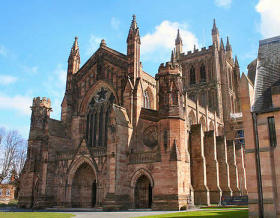 |
| Location |
Contact |
| Hereford town centre |
Hereford Cathedral, 5 College Cloisters, Cathedral Close, Hereford HR1 2NG |
| |
|
| |
w - herefordcathedral.co.uk |
| |
t - 01432 374200 |
| Admission |
Opening |
| Adult £4.50, Child £3.50 |
Daily - Summer Mon to Sat 10am to 4.15pm. Winter Mon to Sat 11am to 3.15pm. |
| Notes:- 1. The world's largest chained library - 1500 rare books 2. Working stonemasons yard. |
|
|
Croft Castle |
|
Croft Castle is now a lavish country mansion but it started life as a Norman stronghold on the border of Wales.
The original castle at this site was an earthern ringwork and has been shown by recent excavation to have been similar to Stokesay Castle. A circular ditch surrounded a curving earthern bank which was topped by a palisade of stout timbers. There were timber buildings within the enclosed area and the ramparts may have been strengthened by the addition of wooden watchtowers.
A larger stone castle was built to replace the earth and timber castle around 1400 AD. The new castle was of quadrangular plan and had high but relatively narrow round towers at each corner. It may also have had projecting square turrets at the mid points of each wall but only the turret on the north side now remains. The four round towers still exist to their original height and their battlements have been restored in later years.
|
|
| Location |
Contact |
| 5 miles North West of Leominster |
Leominster HR6 9PW |
| |
w - nationaltrust.org.uk |
| |
t - 01568 780246 |
| Admission |
Opening |
House and Garden - Adult £4.50, Child £3.50
Garden - £3.50
& £1.55 |
Daily - Summer Mon to Sat 10am to 4.15pm. Winter Mon to Sat 11am to 3.15pm. |
| Notes:- Beautiful period walled garden |
|
The castle was involved in the battle of Mortimer's Cross in 1461 when Sir Richard Croft set forth from it with his soldiers towards the battleground a few miles away. A decendent of Sir Richard fought for King Charles at Stokesay in the 1640's during the English civil war and, following the eventual Royalist defeat, Croft Castle was slighted to render it incapable of further military service.
Restoration took place later in the 17th century when the castle was converted into a mansion but the Croft family sold the castle in 1746 due to financial presures. The castle was then further remodelled in the Gothic style by Richard Knight, the son of a mine owner from Shropsire.
Large ornamental windows now adorn the walls and the original entrance has been replaced by a grand hallway. The original stonework of the towers and lower parts of the high walls between them can be diffentiated from the later work by their distinctive stone blocks. There is no sign of the broad, deep ditch that surrounds similar castles built on flat ground.
The Crofts repurchased their ancestral home in 1923 and Croft Castle is currently maintained for public viewing by The National Trust. It contains rare furniture from the 17th to 19th centuries and has impressive plasterwork and gardens. The earthwork remains of the old ringwork castle can be seen amongst trees in the adjacent meadow. |
|
Berrington Hall |
|
Berrington Hall was built for Thomas Harley, the son of the 3rd Earl of Oxford.
He made a fortune supplying pay and clothing to the British Army in America and became Lord Mayor of London in 1767 at the age of 37.
Harley acquired the Berrington estate in 1775 and immediately commissioned 'Capability' Brown to work on the grounds. Brown took advantage of the panoramic situation of the estate and created a beautiful parkland with a artificial lake and island. The house was built between 1778 - 1781 on a site advised by Brown. This was above the wide valley of a tributary of the River Lugg with views to the Black Mountains and Brecon Beacons. The house was designed by Brown's son-in-law, the fashionable architect Henry Holland, who created Carlton House for the Prince Regent.
The rooms contain a collection of French furniture, including pieces that belonged to the Comte de Flahault, the natural son of Napoleon's step-daughter Hortense and Talleyrand. Harley's daughter, who inherited the estate, was married to the 2nd Lord Rodney, son of Admiral Rodney. |
|
| Location |
Contact |
| 3 miles North of Leominster |
Berrington Hall, Leominster, HR6 0DW |
| |
w - nationaltrust.org.uk |
| |
t - 01568 615721 |
| Admission |
Opening |
| Adult £5, Child £2.50 |
Times vary - phone for details |
| Notes:- 1. Beautiful ceilings and spectacular hall staircase 2. Good collection of furniture and paintings. |
|
The dining room is decorated with huge panoramic paintings of sea battles, three by Thomas Luny, in tribute to the distinguished Admiral who played a significant role in the American War of Independence.
The Rodney family continued at Berrington Hall until 1900 when the estate was sold to Frederick Cawley, later Lord Cawley. Lady Cawley's room displays a photograph of the 1st Lord Cawley and his four sons on horseback in front of the house.
A few years later three of their sons were killed in the First World War.
In 1957 Berrington Hall was accepted by the Treasury in payment of death duty and transferred to the National Trust with some of the contents. The Trust has had to replace much of the pinkish ashlar stonework outside but the remarkable original interior is in a superb state of preservation. |
|
Hampton Court Gardens |
|
Hampton Court Estate is owned by Sola Scriptura, an American non-profit organisation funded by the Van Kampen family.
Hampton Court, Herefordshire is a castle on the meadows of the river Lugg, backed by a steep wooded escarpment and surrounded by woodland and grounds of 1,000 acres. Founded by King Henry in the early 15th century the castle has been completely restored.
The Van Kampen Gardens at Hampton Court are spectacular and although a recent development, are now receiving national recognition. The gardens are open to the public.
Original Victorian garden walls enclose stunning new flower gardens divided by canals, island pavilions and pleached avenues. The kitchen garden is an ornamental garden of fruit and vegetables. It is managed organically, supplying produce to the Orangery Restaurant for its seasonal menu.
Website: Hampton Court gardens |
|
| Location |
Contact |
| A417 near junction withA49 |
Hampton Court Gardens, Hope under Dinmore, Leominster, HR6 0PN |
| |
w - hamptoncourt.org.uk |
| |
t - 01568 797 777 |
| Admission |
Opening |
| Adult £5, Child £3 |
From March 25th - October 30th 2005
Tues, Weds, Thurs and weekends
11am-5pm (last admission 4pm) |
| Notes:-Organically managed site. |
|
There is a maze of a thousand yews with a gothic tower at its centre. Climb to the top for a panoramic view of the gardens or descend underground to a tunnel that leads to a waterfall in the sunken garden. Beautiful herbaceous borders stretch out from a one hundred and fifty year old wisteria tunnel that leads to vast lawns and ancient trees beside the castle. Beyond the lawns are riverside and woodland walks.
Adjoining the castle, in a grand conservatory designed by Joseph Paxton, is the Orangery Restaurant. Here delicious lunches and teas can be enjoyed.
The garden shop, in the garden bothy, sells plants from the garden, homemade produce from the castle kitchens and local crafts and gifts. |
|
Herefordshire Tourist Attractions |
| This page last modified
Monday, 24-Jul-2023 11:24:52 CEST |


